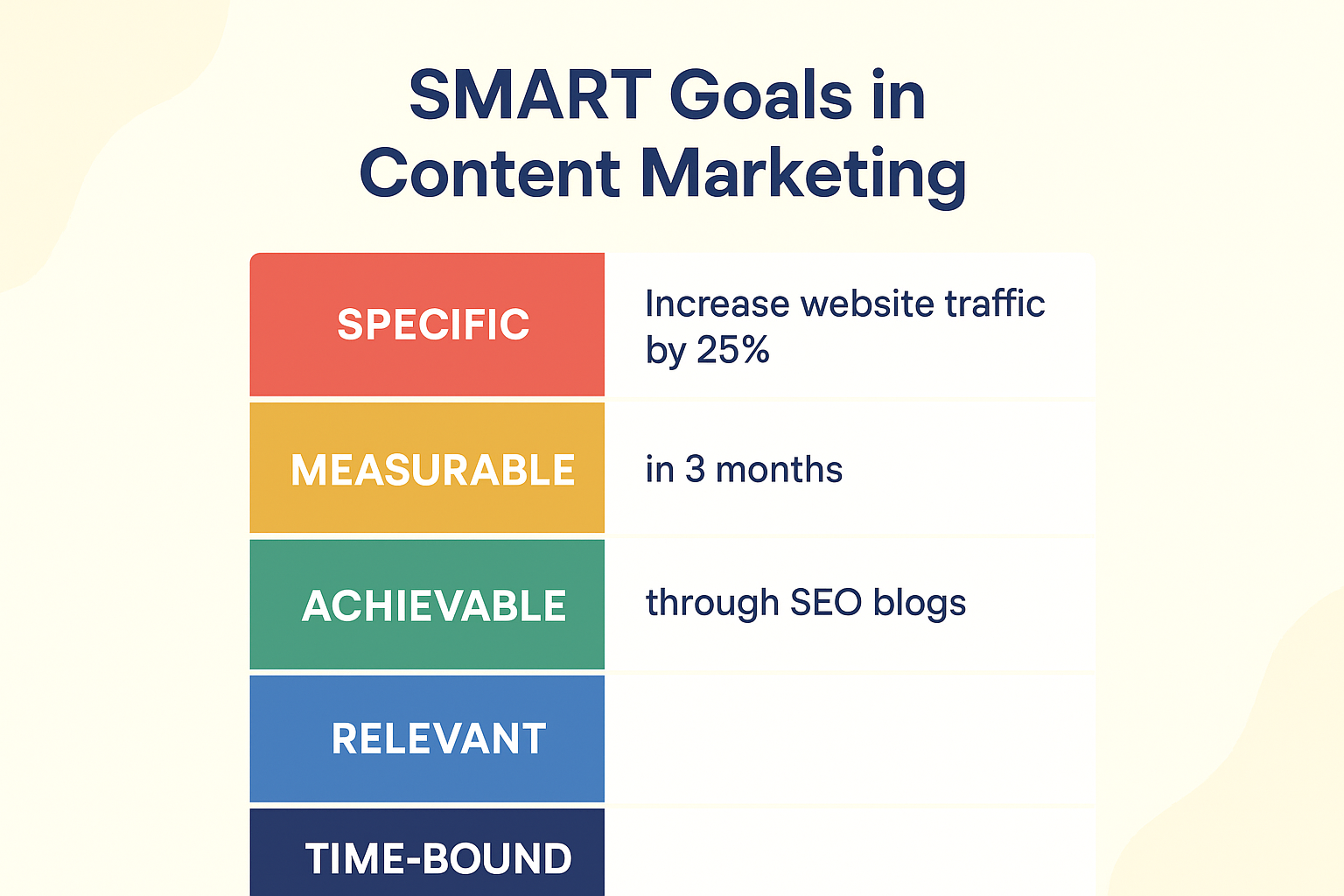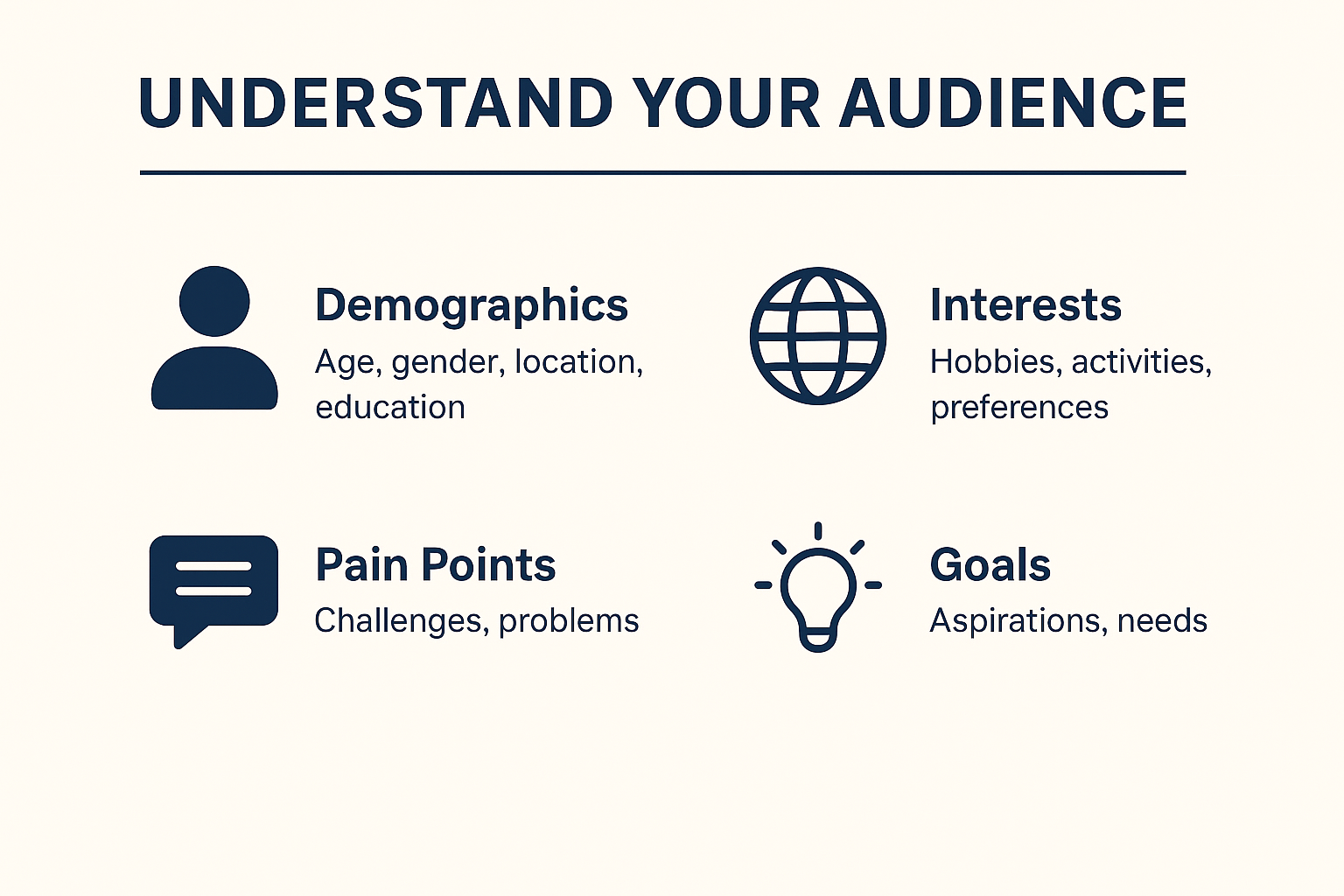How to Set SMART Marketing Goals (With Examples, Templates & KPIs)
Published: 28 Sep 2025
Every business wants growth, but without clear goals, growth turns into guesswork. Setting SMART marketing goals helps you move from random activity to intentional action.

The problem? Many businesses set vague goals like “get more traffic” or “increase sales” without a clear plan.
In this guide, you’ll learn:
- What marketing goals are and why they matter
- How business goals and marketing goals connect
- The SMART framework for creating effective goals
- Types of marketing goals (with examples)
- Common mistakes to avoid
- Real-world case studies
By the end, you’ll know how to design goals that not only look good on paper but also deliver measurable results.
What Are Marketing Goals and Why Do They Matter?
Marketing goals are specific, measurable objectives that guide your marketing strategy. They differ from broad business goals, but the two often work in tandem.
- Business goal example: Increase profits by 20% in 12 months.
- Marketing goal example: Generate 500 new qualified leads in 6 months through content and paid campaigns.
Why Marketing Goals Matter?
- They align your team’s efforts with the company’s big picture.
- They help focus resources on what actually drives growth.
- They provide KPIs (Key Performance Indicators) to measure progress.
Example
A software company shouldn’t just want “more traffic.” A stronger marketing goal would be:
“Increase free trial sign-ups by 30% in the next 6 months by targeting long-tail keywords and running LinkedIn ads.”
How to Set SMART Goals

Before jumping into marketing campaigns, it’s important to pause and define exactly what you want to achieve. Goals like “boost brand awareness” or “increase sales” sound appealing, but they’re too vague to provide real direction. That’s where the SMART framework comes in.
SMART goals are designed to make your objectives clear, measurable, and actionable. The acronym stands for:
- Specific – What exactly do you want to accomplish?
- Measurable – How will you track success or failure?
- Attainable – Is this goal realistic with your current resources?
- Relevant – Does this goal support your company’s larger vision?
- Time-bound – By when should the goal be achieved?
Using this framework ensures that your marketing goals aren’t just wishful thinking. Instead, they become practical, trackable steps that guide your campaigns with purpose and clarity.
Example: Turning a Vague Idea Into a SMART Goal
Imagine you’re a digital marketer for a photo-sharing company. Customers can upload photos and create custom scrapbooks, albums, and other keepsakes. The business wants to increase scrapbook sales in the upcoming quarter.
A vague goal might be: “We want to sell more scrapbooks.”
But a SMART goal would look like this:
“Increase scrapbook sales by 15% by the end of the next quarter through a targeted social media campaign that uses influencer partnerships.”
This revised goal works because it’s:
- Specific (increase scrapbook sales)
- Measurable (15% growth)
- Attainable (realistic target)
- Relevant (supports company’s focus on scrapbook sales)
- Time-bound (within the next quarter)
By following SMART criteria, you now have a roadmap to track progress, evaluate results, and adjust strategies as needed.
Business Goals vs. Marketing Goals
Think of your business as a pyramid:
- At the top: Business goals → broad, long-term outcomes (profits, expansion, innovation).
- Below: Marketing goals → tactical steps that directly support business goals.
Characteristics of Business Goals
- Broad and strategic
- Long-term focus (1–5 years)
- Measurable at the company-wide level
- Not tied to a single department
Examples
- Increase annual revenue by 20%
- Expand into three new international markets within two years
- Reduce operational costs by 10%
Characteristics of Marketing Goals
- Narrower and more focused
- Short to medium-term (3–12 months)
- Directly connected to marketing activities
- Measurable with KPIs
Examples
- Increase website traffic by 30% in six months
- Generate 500 new leads per month through paid ads
- Achieve a 5% conversion rate on landing pages
How They Work Together
Example 1 – Amazon (Expansion Goal):
- Business Goal: Expand into South America, capture 10% market share in 2 years.
- Marketing Goals:
- Run localized ad campaigns to increase brand awareness by 60%.
- Partner with influencers to gain 100,000 followers in 6 months.
- Boost organic search traffic by 40% through region-specific SEO.
- Run localized ad campaigns to increase brand awareness by 60%.
Example 2 – Nike (Revenue Goal):
- Business Goal: Increase total revenue by 15% this year.
- Marketing Goals:
- Launch a global social media campaign to boost online sales by 20%.
- Increase Nike app downloads by 25% in 6 months.
- Grow loyalty program memberships by 10%.
- Launch a global social media campaign to boost online sales by 20%.
Without marketing goals, business goals are just dreams.
Types of Marketing Goals You Can Set
Different businesses prioritize different goals. The most common ones include:
- Increase brand awareness → track social shares, impressions, branded searches.
- Generate more leads → measure form fills, webinar sign-ups, downloads.
- Boost sales or conversions → monitor purchases, sign-ups, bookings.
- Improve customer retention → loyalty program members, repeat purchases.
- Enhance engagement → average session time, video views, email click-through rate.
Example:
A bakery could set:
“Grow Instagram engagement by 20% in 3 months through daily Stories and influencer partnerships.”
Understand Your Audience Deeply

Goals only work if you know who you’re targeting.
Steps to Understand Your Audience
- Build buyer personas: demographics, behaviors, pain points.
- Use analytics: check top-performing content, bounce rates.
- Apply social listening: see what your audience is talking about.
- Run surveys: ask customers what they really need.
- Study keyword intent: analyze search behavior.
Example:
A fitness brand targeting busy professionals discovers their audience prefers short workout guides. Instead of a vague goal like “increase sales,” they set:
“Generate 200 new leads in 3 months by offering free 10-minute workout ebooks.”
Choosing the Right KPIs for Each Goal
KPIs help measure whether your marketing goals are working.
- Brand awareness: reach, impressions, branded search volume.
- Lead generation: number of leads, cost per lead, conversion rate.
- Sales: revenue, average order value, customer acquisition cost.
- Engagement: bounce rate, time on site, click-through rate.
Example:
If your goal is “increase lead generation by 30%,” your KPI could be: “Number of new leads generated per campaign.”
Aligning Marketing Goals With the Sales Funnel
Not all goals are equal. Tie them to customer journey stages:
- TOFU (Top of Funnel): Awareness – reach, impressions, engagement.
- MOFU (Middle of Funnel): Consideration – lead generation, email sign-ups.
- BOFU (Bottom of Funnel): Decision – conversions, sales, upsells.
Example Funnel:
- TOFU: Reach 100,000 people via social ads.
- MOFU: Convert 10% into email leads.
- BOFU: Convert 5% into paying customers.
Setting Channel-Specific Marketing Goals
Each channel has its own KPIs and success metrics.
- SEO: Rank in top 3 for “best noise-canceling headphones” within 6 months.
- Social media: Grow LinkedIn followers by 25% in 90 days.
- Email marketing: Achieve 15% CTR in newsletters within 6 months.
- Paid ads: Reduce cost per acquisition by 20% in 3 months.
Example:
An e-commerce store could set:
“Increase conversion rate from Facebook ads by 15% in 6 months by testing new creatives.”
Common Mistakes to Avoid When Setting Goals
- Setting too many goals → spreads focus thin.
- Chasing vanity metrics (likes, follows) → no real impact.
- Making goals too vague → impossible to measure.
- Ignoring customer insights.
- Skipping deadlines.
How to Track and Measure Progress
Your goals only work if you track them consistently.
Tools to Use:
- Google Analytics 4: Website traffic & conversions.
- Looker Studio: Custom dashboards.
- HubSpot / Salesforce: Lead tracking.
- SEMrush / Ahrefs: SEO growth.
- Hootsuite / Sprout Social: Social engagement.
Example:
If your KPI is organic traffic, track it monthly in GA4. If growth slows, adjust your content topics.
Real-World Examples
a) SaaS Company
- Business Goal: Grow customers by 25% in 2 years.
- Marketing Goal: Increase free trial sign-ups by 30% in 6 months.
- KPI: Trial-to-paid conversion rate.
b) E-commerce Store
- Business Goal: Increase revenue by 20% in 1 year.
- Marketing Goal: Boost repeat purchases by 15% via loyalty programs.
- KPI: Repeat customer rate.
c) Local Business
- Business Goal: Expand local customer base.
- Marketing Goal: Generate 300 new leads in 90 days with Facebook ads.
- KPI: Number of new calls/bookings.
Final Remarks
Marketing without goals is like driving without a map—you might move forward, but you’ll never know where you’re heading.
By setting SMART, measurable goals that align with your business objectives, choosing the right KPIs, and tracking progress, you can create a roadmap for steady growth.
👉 Start small. Pick one or two goals, track them consistently, and refine as you go. Success will follow.
FAQs
1. What’s the difference between business goals and marketing goals?
Business goals are big-picture outcomes (profits, expansion). Marketing goals are measurable targets that support them.
2. What are SMART goals in marketing?
SMART = Specific, Measurable, Achievable, Relevant, Time-bound.
3. How do I pick the right KPI?
Choose a KPI that directly measures progress. Example: For lead generation → number of new leads.
4. How many goals should I set?
Focus on 1–2 main goals and 2–3 supporting ones. Too many causes distract.
5. How often should I review marketing goals?
At least quarterly. Review performance, adjust tactics, and realign with business objectives to ensure alignment with overall goals.

- Be Respectful
- Stay Relevant
- Stay Positive
- True Feedback
- Encourage Discussion
- Avoid Spamming
- No Fake News
- Don't Copy-Paste
- No Personal Attacks

- Be Respectful
- Stay Relevant
- Stay Positive
- True Feedback
- Encourage Discussion
- Avoid Spamming
- No Fake News
- Don't Copy-Paste
- No Personal Attacks





